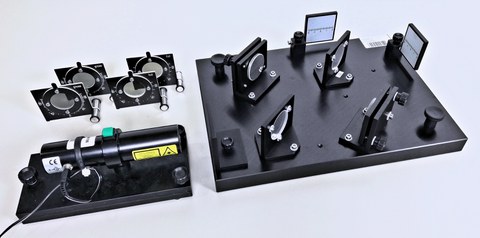Research areas
Quantum technology in school and higher education
For a long time now, research has focussed on teaching quantum physics. The starting point is the modern approach via two-state systems and quantum optics. The key point is the identification and understanding of central concepts of quantum theory, which are also relevant for the formation of a modern physical world view. Modern quantum technologies are chosen as the context, in particular quantum cryptography and quantum computers.
The Chair of Physics Education is also jointly responsible for the GIREP Thematic Group "Teaching and learning in quantum physics", which anchors this topic at GIREP conferences.
Mathematics in physics lessons
A central research area of the chair of didactics of physics in Dresden is the interplay between maths and physics in physics education. The basis is formed by fundamental considerations on the role of mathematics in physics with significance for schools and teacher training. Building on this, the research field is approached from several perspectives. The focus is on the first steps towards mathematisation in secondary level 1, as this is an area that has been largely neglected in research on mathematisation to date. In addition to formulae and equations, a wide range of other mathematical elements are also included in the research in a broad sense. The main aim of the research is to identify specific strategies and problems faced by pupils when using mathematical elements in physics and to develop interventions in lessons and teacher training.
Digital media in physics lessons
The chair of didactics of physics at TU Dresden has been conducting intensive research into the potential uses of digital media in physics lessons for a number of years. This includes, in particular, the use of sensors, smartphone apps and critical reflection on their use in physics lessons. This is also reflected in teaching.
Nature of science
As a genuinely interdisciplinary bridging field, physics didactics mediates between physics and educational sciences. The current findings of the philosophy of science and the philosophy of physics form the basis for an understanding of what physics is in its essence (nature of science). These support, for example, the thesis that highly mathematised physics has a special function among the individual sciences as a universal and fundamental, paradigmatic science. In recent years, the guidelines for the training of future physics teachers have increasingly called for the inclusion of aspects of the philosophy and history of physics so that, in the sense of a broad general education, orientation knowledge about the nature of physics can be incorporated into later school lessons in addition to knowledge about the content of physics. To this end, courses on the history of physics are offered on a regular basis in order to at least be able to include corresponding topics in the more specialised subject-specific and physics didactic training. In courses on teaching quantum physics, questions of interpretation are also addressed.

